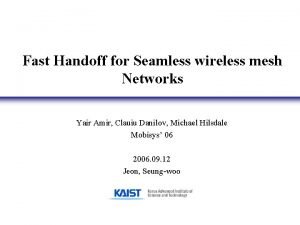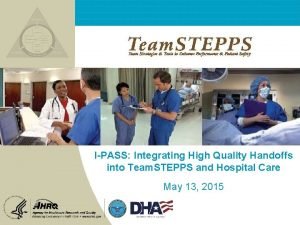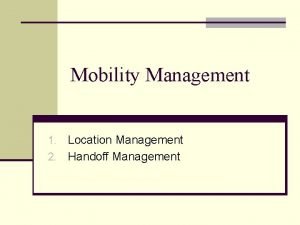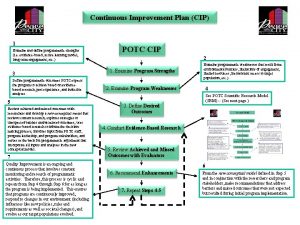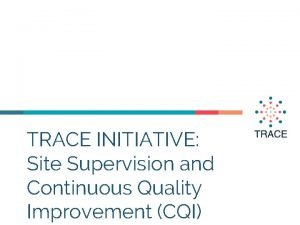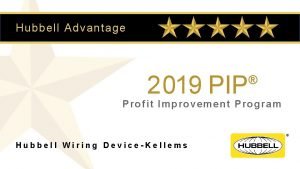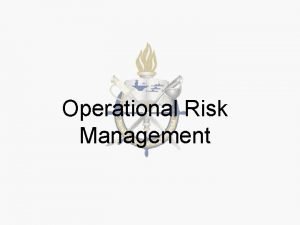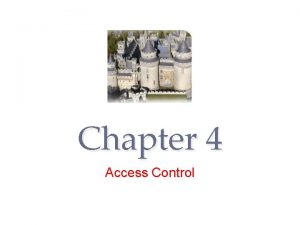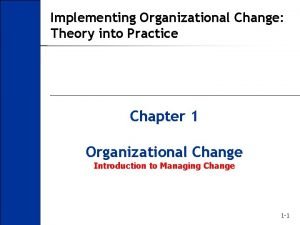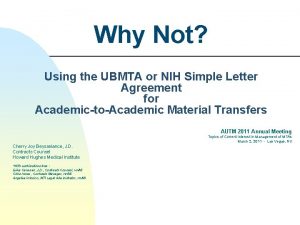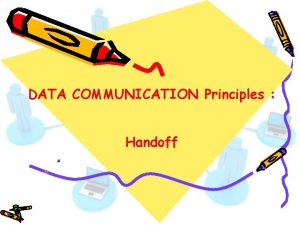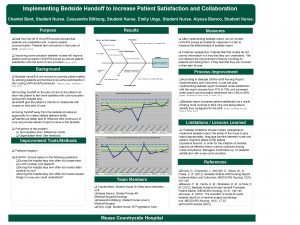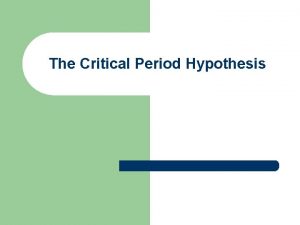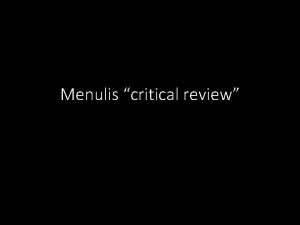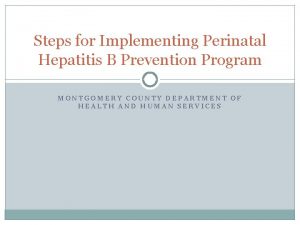Implementing a Handoff Improvement Program Critical Steps for












































- Slides: 44

Implementing a Handoff Improvement Program: Critical Steps for Success

Successful Implementation of I-PASS What does success look like? • Everyone trained in I-PASS • Everyone using I-PASS consistently • Miscommunications, errors and patient harm reduced What does success require? • Core training (i. e. basic knowledge) • Observation/feedback in workplace to improve performance • Measure outcomes to improve and sustain

Intervention: I-PASS Handoff Bundle Components I-PASS Mnemonic I-PASS Campaign Structured Observation & Feedback Introductory Workshop I-PASS Handof f Bundle Faculty Development Team. STEPPS Training Simulation Exercises I-PASS Printed Handoff Document

I-PASS Implementation Steps 1. Establish Institutional Support and Ensure Team Organization 2. Assess the Local Environment 3. Consider Need to Adapt I-PASS and/or the Local Environment 4. Determine Implementation Scope 5. Develop a Communication Plan 6. Ensure Ongoing Data Collection and Iterative Improvement Cycles 7. Plan for Implementation 4

I-PASS Implementation Steps 1. Establish Institutional Support and Ensure Team Organization 2. Assess the Local Environment 3. Consider Need to Adapt I-PASS and/or the Local Environment 4. Determine Implementation Scope 5. Develop a Communication Plan 6. Ensure Ongoing Data Collection and Iterative Improvement Cycles 7. Plan for Implementation 5

Institutional Support and Team Organization Local institutional support = strong Ongoing sponsorship and support are critical! • Chief medical, safety and/or quality officers • Training program directors • Division and Department Chairs Commitment from Executive Sponsors ensures goals of implementation align with institution’s strategic goals I-PASS Champions also needed

I-PASS Study Group IIPE Coordinating Council Carol Carraccio (Director) Dorene F. Balmer Laura E. Degnon David Mc. Donald Alan J. Schwartz Christopher P. Landrigan (PI/Chair) Boston Children’s Hospital Amy J. Starmer (Project Leader) Boston Children’s Hospital Oregon Health and Science University Scientific Oversight Committee PRIS Executive Council PRIS Advisory Board Jonathan D. Klein (AAP) Benard P. Dreyer (APA) Brent C. James (IH) Maureen Bisognano** (IHI) Charles Horner (NICHQ) Michael R. Burke (SHM) Becky Blankenburg* Lauren Destino Jennifer Everhart Shilpa J. Patel Education Executive Committee Nancy D. Spector (Co-chair) Amy J. Starmer (Co-chair) Christopher P. Landrigan Sanjay Mahant Theodore C. Sectish Nancy D. Spector Rajendu Srivastava Amy J. Starmer Daniel C. West Karen M. Wilson Rajendu Srivastava (Chair) Jaime Blank Patrick H. Conway Ron Keren Sanjay Mahant Christopher P. Landrigan Samir S. Shah Tamara D. Simon Joel S. Tieder Karen M. Wilson Leah E. Willis Lucile Packard Children’s Hospital Jaime Blank Elizabeth L. Noble Theodore C. Sectish Nancy D. Spector Rajendu Srivastava Lisa L. Tse James F. Bale Zia Bismilla Sharon Calaman Maitreya Coffey F. Sessions Cole Lauren Destino Jennifer Everhart Jennifer Hepps Christopher P. Landrigan Joseph O. Lopreiato UCSF Benioff Children’s Hospital Glenn Rosenbluth* Daniel C. West Campaign Subcommittee Data Coordinating Center Dissemination Subcommittee Brigham and Women’s Hospital Theodore C. Sectish (Co-chair) Nancy D. Spector (Co-chair) Christopher P. Landrigan Elizabeth L. Noble Rajendu Srivastava Amy J. Starmer Lisa L. Tse Jeffrey M. Rothschild* Katherine R. Zigmont Christopher P. Landrigan Stuart R. Lipsitz Amy J. Starmer Matthew F. Wien Catherine S. Yoon Primary Children’s Hospital (Utah) James F. Bale* Rajendu Srivastava Adam T. Stevenson St. Louis Children’s Hospital F. Sessions Cole* Kevin T. Barton Michael P. Turmelle Andrew J. White Elizabeth L. Noble Jennifer K. O’Toole Shilpa J. Patel Glenn Rosenbluth Theodore C. Sectish Rajendu Srivastava Adam T. Stevenson Lisa L. Tse Daniel C. West Clifton E. Yu Glenn Rosenbluth (Chair) Sharon Calaman Lauren Destino Jennifer Everhart Jennifer Hepps Christopher P. Landrigan Jennifer K. O’Toole Shilpa J. Patel Theodore C. Sectish Nancy D. Spector Amy J. Starmer Adam T. Stevenson Clifton E. Yu Cincinnati Children’s Hospital for Sick Children (Toronto) National Capital Consortium Jennifer K. O’Toole* Lauren G. Solan Maitreya Coffey* Zia Bismilla Sanjay Mahant Jennifer Hepps* Joseph O. Lopreiato* Clifton E. Yu* Simulation Subcommittee Faculty Development Subcommittee Sharon Calaman (Chair) Jennifer Hepps Joseph O. Lopreiato Clifton E. Yu Jennifer K. O’Toole (Cochair) Nancy D. Spector (Cochair) Glenn Rosenbluth Theodore C. Sectish Amy J. Starmer Daniel C. West Clifton E. Yu St. Christopher’s Doernbecher Children’s Hospital for Children Hospital (OHSU) Sharon Calaman* Nancy D. Spector Amy J. Starmer* Megan Aylor Windy Stevenson Tamara L. Wagner

I-PASS Site Organizational Chart 8

Overcoming Barriers First line providers • • “We already know how to sign out” “We use SBAR!” It will increase the length of the handoff It may work for doctors , but not for nurses Senior Providers • It may work for the residents, but not for us • It doesn’t apply to our setting • Are there any data that it works? 9

Overcoming Barriers Institution or unit • IT department will not support this • It is disruptive to current workflow Protected time for a handoff is problematic Protected time for training is problematic 10

Implementation = Culture Change The content of I-PASS was the easy part! Change is hard, even if everyone wants to change

Implementation = Culture Change Doing it right requires: • Hospital leadership support • Champions • Stakeholder input • Time and patience …. . it cannot be done in a few months • Commitment to make the change real…. . a three hour workshop and a mnemonic are not enough • Improvement cycles • Willingness to tailor to local needs

Changing Culture Is Not Easy Behavior change takes a long time Need to sustain the effort • Repeat curriculum for new learners • Continue observations and tracking adherence Feedback is essential

I-PASS Implementation Steps 1. Establish Institutional Support and Ensure Team Organization 2. Assess the Local Environment 3. Consider Need to Adapt I-PASS and/or the Local Environment 4. Determine Implementation Scope 5. Develop a Communication Plan 6. Ensure Ongoing Data Collection and Iterative Improvement Cycles 7. Plan for Implementation 14

Needs Assessment Completion of a needs assessment activity offers insight into current handoff practices and critical areas of vulnerability Best conducted as a collaborative effort including Front-line providers, I-PASS Champions and other key stakeholders Documentation of discussion strongly encouraged 15

Needs Assessment: Key Domains Inventory of all handoff types on unit of focus • • Time of day Team members involved Type of information exchanged Census Describe patterns of information exchange for verbal and written handoffs Discuss anticipated options and barriers for implementation 16

Process Mapping: Current State 17

Process Mapping: Ideal State 18

I-PASS Implementation Steps 1. Establish Institutional Support and Ensure Team Organization 2. Assess the Local Environment 3. Consider Need to Adapt IPASS and/or the Local Environment 4. Determine Implementation Scope 5. Develop a Communication Plan 6. Ensure Ongoing Data Collection and Iterative Improvement Cycles 7. Plan for Implementation 19

Adapting IPASS and/or the Local Environment Sometimes modifications of the local environment are necessary in order to incorporate all components of the handoff program Sometimes elements of I-PASS need to be modified or adapted to fit the needs of a local environment 20

Adaptation of I-PASS: Guiding Principles Keep the I-PASS mnemonic intact Retain training on general principles of high functioning teams Engage Champions and Front-line providers to ensure consensus is achieved Reinforce handoff skills through direct observation Refine implementation

I-PASS Implementation Steps 1. Establish Institutional Support and Ensure Team Organization 2. Assess the Local Environment 3. Consider Need to Adapt I-PASS and/or the Local Environment 4. Determine Implementation Scope 5. Develop a Communication Plan 6. Ensure Ongoing Data Collection and Iterative Improvement Cycles 7. Plan for Implementation 22

Determining Implementation Scope Define short-term and long-term scope of IPASS Implementation efforts Recommendation: start small! • Small scale local wins are more likely to spread • Serial testing and learning on a small scale makes broad scale implementation more manageable Select units in the short-term that are on board and include early adopters 23

I-PASS Implementation Steps 1. Establish Institutional Support and Ensure Team Organization 2. Assess the Local Environment 3. Consider Need to Adapt I-PASS and/or the Local Environment 4. Determine Implementation Scope 5. Develop a Communication Plan 6. Ensure Ongoing Data Collection and Iterative Improvement Cycles 7. Plan for Implementation 24

I-PASS Communication Plan Timely and effective communication critical • Raise awareness about anticipated changes • Assists adopters transition from awareness to conscious decision to change behaviors Ensure all stakeholders aware of key timelines, particularly if impacts 25

Sample I-PASS Communication Plan Stakeholder Communication Goal Information to Communicate Advisory Board Continued support from Advisory Board Members Handoff Team progress Timing of Communications Communication Method Quarterly (July 1, Oct 1, Jan 1, Initial Meeting and formal Apr 1) presentation by Handoff Team Leads ; subsequent quarterly email updates Front-line providers Gather input from front line Timeline for implementation During scheduled Morning Education Working Group providers for revision of Current written tool and ideal Report Conference meeting with Frontline written tool April 15 Providers Faculty on call for pilot unit Ensure on call faculty for go- Logistics for data collection 2 weeks prior to go-live ( on Email live month aware of pilot and observations June 1); Reminder observations required for communication on go-live data collection and date and as needed evaluation of handoffs Administration Secure resources Resources needed for I-PASS Ongoing (at least 1 month Face-to-face campaign material, internal prior to event date or date website advertisement, material is needed) available funding, food incentives, consultative services Inpatient unit nurses for pilot Develop strategies for IPASS Placement of I-PASS Next nursing staff meeting In person as well as in person unit campaign material, bulletins, April 13 th meeting prior to staff Garner nursing staff support rewards for small meeting with nurse manager accomplishments and incentives (food, etc. ) in patient care areas and report station; Front Line Providers Praise and Encouragement to Thank you message, June 15 go live Email continue I-PASS pilot encouragement message July 30 August 30 I-PASS Mentors Continued consultation Pilot progress At each phase of Teleconference and email services implementation or as needed 26 Next call March 30

Sample I-PASS Communication Plan Stakeholder Communication Goal Information to Communicate Timing of Communications Method Advisory Board Continued support from Advisory Board Members Handoff Team progress Quarterly (July 1, Initial Meeting and Oct 1, Jan 1, Apr 1) formal presentation by Handoff Team Leads ; subsequent quarterly email updates During scheduled Education Working Morning Report Group meeting Conference with Frontline April 15 Providers Front-line providers Gather input from Timeline for front line providers for implementation revision of written tool Current written tool and ideal written tool 27

I-PASS Implementation Steps 1. Establish Institutional Support and Ensure Team Organization 2. Assess the Local Environment 3. Consider Need to Adapt I-PASS and/or the Local Environment 4. Determine Implementation Scope 5. Develop a Communication Plan 6. Ensure Ongoing Data Collection and Iterative Improvement Cycles 7. Plan for Implementation 28

Data is Critical Data collection, analysis, and feedback to team members: Critical to I-PASS implementation Performance measures should Map back to aims of implementation Address areas of critical vulnerability and challenges Track performance longitudinally Actually be collected! 29

Analysis and Interpretation of Data: Run Charts Run charts offer several advantages over pre- post- summary data • Visual representation of what’s working (or not) • Regular review of impact of different aspects of interventions as they occur Recommendations: • Regular review of data on a monthly basis with key I-PASS Champions for PDSA development • Regularly scheduled sessions to review data with Front-line Providers • Posting of data in shared areas

Monthly Averages Median August (n=02) July (n=02) June (n=02) May (n=02) Apr (n=06) Mar (n=11) Feb (n=01) Jan (n=05) Dec (n=07) Nov (n=06) Oct (n=05) Sept (n=02) Aug (n=03) Jul (n=04) Jun (n=07) Monthly Average Sample I-PASS Run Chart Percent of Residents Adhering to 5 Elements of I-PASS Mnemonic 120 100 80 60 40 20 0 Axis Title Goal (90) 31

Establishing Key Outcome Metrics Once goals and timeline are in place, need to decide how to measure attainment Collecting data is critical • Are we headed in the right direction? • How do our strategies need to be adjusted in order to achieve our goals List of metrics should be balanced in order to understand how all aspects of I-PASS Handoff Bundle implementation are going • Structure, Process, Outcomes, Balancing measures

Potential Outcome Metrics Training Penetrance Percent of Front-line Providers trained Percent of I-PASS Champions trained Verbal Handoffs Assessment of adherence with the standardized I-PASS format for the giver of the handoff Rates of faculty-documented miscommunications for the giver of the handoff Assessment of the engagement of the receiver of the handoff Printed Handoff Tool Assessment of adherence with the standardized I-PASS format Assessment of frequency of miscommunications Provider Experience Surveys Perception of the quality of verbal and written handoffs Perceived frequency of handoff related medical errors

Turning Goals and Metrics into Specific Aims Specific aims offer clear direction by including original goals, a clear timeline, and measures Aims should be SMART • Specific, Measurable, Achievable (and Aggressive), Realistic (and Relevant), and Time-bound Example specific aim: • Within the next 12 months, 80% of verbal handoff sessions for the giver will usually or always include each element of the I-PASS mnemonic

Developing a Data Collection and Reporting Plan Collect minimum of 2 months of baseline data prior to finalization of measures Once measures finalized, establish ongoing data collection and reporting routine for each measure Measure (with operational definition) Who collects the data? Collection frequency Who reports it? How often is it reported? Notes How is it reported to IPASS champions and front-line providers Verbal handoff I -PASS mnemonic adherence Written handoff mnemonic adherence Other selected metrics

Ongoing Iterative Improvement Cycles Regular review of data should include development of PDSA cycles for improvement • los ciclos PHVA (Planificar, Hacer, Verificar y Actuar)

PDSA / “PHVA” Cycle Log For each PDSA cycle, identify: • Problem being addressed with test of change • Description of intervention • Individual responsible for oversight • Measures that will indicate success • Tasks / action items necessary to complete test of change • Responsible person • Timeframe for completion / deadline • Outcome

I-PASS Implementation Steps 1. Establish Institutional Support and Ensure Team Organization 2. Assess the Local Environment 3. Consider Need to Adapt I-PASS and/or the Local Environment 4. Determine Implementation Scope 5. Develop a Communication Plan 6. Ensure Ongoing Data Collection and Iterative Improvement Cycles 7. Plan for Implementation 38

Planning for Implementation Documentation of a timeline for implementation of all key I-PASS Bundle elements is critical 39

I-PASS Implementation Steps 1. Establish Institutional Support and Ensure Team Organization 2. Assess the Local Environment 3. Consider Need to Adapt I-PASS and/or the Local Environment 4. Determine Implementation Scope 5. Develop a Communication Plan 6. Ensure Ongoing Data Collection and Iterative Improvement Cycles 7. Plan for Implementation 40

Final Step (lo más importante!!): Celebrate Success!

Take Home Points High frequency of communication and handoff errors I-PASS Handoff Bundle decreased rates of medical errors and adverse events Teamwork, planning, and anticipation of resistance to change are key components of 42

Acknowledgements I-PASS Study Group 43

Better handoffs. Safer care. Any Questions? amy. starmer@childrens. harvard. edu www. ipasshandoffstudy. com
 Critical semi critical and non critical instruments
Critical semi critical and non critical instruments Critical semi critical and non critical instruments
Critical semi critical and non critical instruments Mesh wifi handoff
Mesh wifi handoff Ipass the baton example
Ipass the baton example Network controlled handoff
Network controlled handoff 5 p's of patient handoff
5 p's of patient handoff Juran 10 steps to quality improvement
Juran 10 steps to quality improvement 8 step improvement
8 step improvement Quality is free: the art of making quality certain
Quality is free: the art of making quality certain Slidetodoc.com
Slidetodoc.com Cip 1
Cip 1 Airport improvement program aip
Airport improvement program aip Cqi action plan template
Cqi action plan template Bobby hawthorne
Bobby hawthorne Profit improvement program
Profit improvement program Productivity improvement program
Productivity improvement program One case of dehydrated milk
One case of dehydrated milk Critical thinking in nursing process
Critical thinking in nursing process Control of critical steps and intermediates
Control of critical steps and intermediates Time critical risk management steps
Time critical risk management steps Hrd program implementation
Hrd program implementation Chapter 7 strategic management
Chapter 7 strategic management Implement strategies management issues
Implement strategies management issues Chapter 7 strategic management
Chapter 7 strategic management Tripod pricing strategy
Tripod pricing strategy Implementing merchandise plans
Implementing merchandise plans Designing and implementing brand architecture strategies
Designing and implementing brand architecture strategies Designing and implementing branding strategies
Designing and implementing branding strategies Portfolio assessment matches assessment to teaching
Portfolio assessment matches assessment to teaching Crm vision statement examples
Crm vision statement examples Implementing qsen competencies
Implementing qsen competencies Challenges of implementing predictive analytics
Challenges of implementing predictive analytics Implementing organizational change spector
Implementing organizational change spector Implementing strategies marketing finance/accounting
Implementing strategies marketing finance/accounting Is the traditional method of implementing access control
Is the traditional method of implementing access control Simplified scoring model in project management
Simplified scoring model in project management Implementing strategies management and operations issues
Implementing strategies management and operations issues Toyota brand architecture
Toyota brand architecture Nfpa 1600
Nfpa 1600 Implementing organizational change theory into practice
Implementing organizational change theory into practice Ubmta
Ubmta Nfpa business continuity
Nfpa business continuity Zpf cisco
Zpf cisco Implementing strategies management and operations issues
Implementing strategies management and operations issues Dance locomotor movements
Dance locomotor movements


